Governor General’s Foot Guards choose design by Carleton students for Commemorative Gate Project
March 4, 2022
Architecture students at Carleton University have produced the design concept for a new commemorative gate proposed for Ottawa’s Confederation Park, marking the 150th anniversary of the Governor General’s Foot Guards (GGFG).
“The Governor General’s Foot Guards Regimental Association was absolutely pleased with the professionalism and quality of work demonstrated by the students and staff at the Azrieli School of Architecture & Urbanism,” said Major Gray Shanahan, project leader for the GGFG Commemorative Gate Project.
“We were looking to build a new signature landmark in downtown Ottawa, and the complex criteria were synthesized into a stunning design.”
In January, third-year students in the conservation and sustainability program, led by Adjunct Professor Lyette Fortin, produced eight design proposals for consideration.
Four finalists emerged after a presentation to the regimental association and the National Capital Commission, custodian of Confederation Park.
On March 4, the GGFG 150th Organizing Committee announced the winning proposal, Standing Steady, by students Erika Colmenares-Di Maria and Tess Coman.
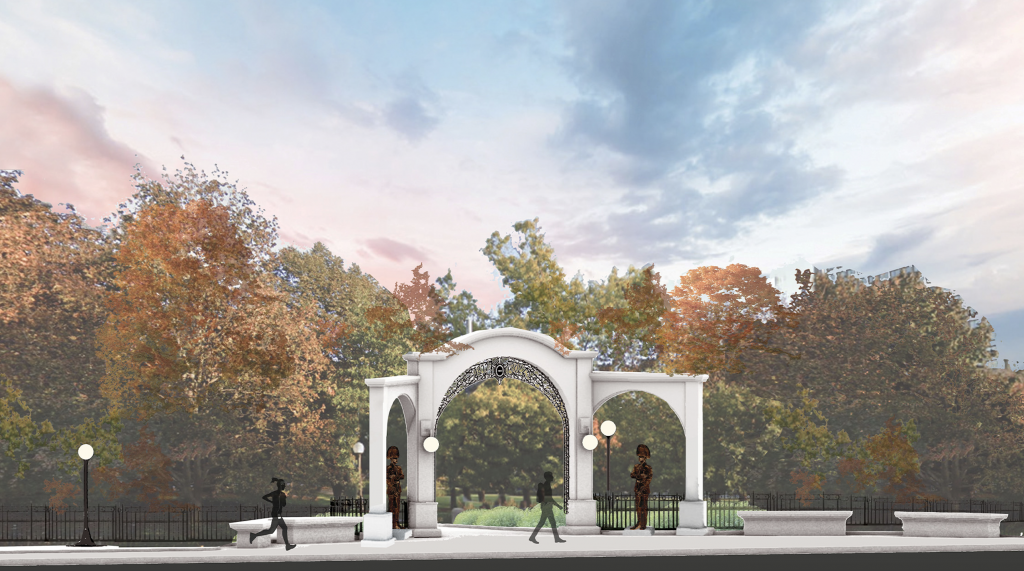
Standing Steady, by students Erika Colmenares-Di Maria and Tess Coman.
It takes the form of a gateway to Confederation Park, made up of three linked stone arches. Visitors will pass through an arch that marks the threshold between the sidewalk along Laurier Avenue and the park landscape. The two smaller flanking arches hold bronze sculptures of foot guards at attention.
A slender inner arch of wrought iron tracery, alluding to natural plant forms, accents the central bay. The Guard’s Star, a heraldic emblem, is set in the centre of the ironwork. The design takes inspiration from the three arches on the facade of Cartier Square Drill Hall, home of the regiment.
The site at the south entrance of Confederation Park is across the street from the Cartier Square Drill Hall. The park contains numerous military memorials and is along the Veteran’s Affairs “memorial route” and the route the Ceremonial Guard takes to Parliament Hill.
The regiment has trained across from the park since its inception in 1872, particularly when it was mostly an open field before city hall and the courthouse were constructed. The regiment also utilizes the park for regimental events and activities. The gate would reinstate the regiment’s presence in the park after the Rodgers and Osgoode statue was relocated from it in 2006.
“This project was fun and upbeat from start to finish, and our group is so grateful for the opportunity that this project gave us,” said Colmenares-Di Maria.
The Governor General’s Foot Guards was established in Ottawa on June 7, 1872, and is the most senior reserve infantry regiment in Canada.
The GGFG performs the mounting of the Ceremonial Guard on Parliament Hill and provides soldiers and a band for military duties at Rideau Hall, the National War Memorial, and other ceremonial tasks in the National Capital Region.
Last December, the regimental association approached the school to see if there was interest in developing designs for the dedicated memorial entrance it planned as a legacy project celebrating its 150th anniversary.
“I thought it would be an exciting short project for the students to start the winter semester,” says Fortin, whose teaching assistant was Jillian Weinberger.
Eighteen students took part in the three-week project. They worked in eight teams and developed eight design proposals in three phases.
The project design goals include protecting and enhancing the heritage value of the site and cultural landscape and harmonizing with existing monuments, which include the National Aboriginal Veterans Monument and the Animals in War Dedication.
“Working with a real client on something they want, with the ability to be creative was an experience I will never forget,” said student Terissa Chalmers, whose project Gate of Stories, executed with Maya Thayalan, was one of the finalists.
In phase one, the students undertook research and did a site visit. They produced a report that synthesized the client’s vision and requirements, explored the history of the GGFG, and analyzed the site’s history, from Indigenous to present. They also
assessed the character-defining elements of surrounding buildings and cultural landscape and analyzed precedents of other commemorative gates in Canada and abroad.
In phase two, the students developed a preliminary design and schematic studies of their design ideas for the gate and its relationship to the context.
They translated their preliminary design ideas into a comprehensive overall design on a presentation panel in phase three.
The client provided feedback on all three phases of the project.
“I am just blown away at the effort that has been put in by the students — their imagination and attention to detail, let alone the artistry of all of their presentation boards,” said L. Col. Fran Chilton-Mackay, executive director of the GGFG 150th Organizing Committee. “WOW!”
Fortin notes that there are other stakeholders and interested organizations in addition to the regiment. These include the City of Ottawa, the National Capital Commission, Public Services and Procurement Canada, Heritage Canada, Rideau Hall, and the private sector for funding.
The winning design concept will go to a firm of practicing architects, and they will produce working drawings and specifications for the construction. The student designers will receive credit for the design and $5,000.
The GGFG is fundraising for the gate, which they hope to build next year. The goal is $1 million.
“I thank the Governor General’s Foot Guards Regimental Association for providing this wonderful opportunity to the students,” says Fortin.
“All eight teams demonstrated how their meaningful design proposals represented and conveyed the values of the Governor General’s Foot Guards and at the same time respected and enhanced the heritage values of Confederation Park, the site, the context, and the cultural landscape.
“While only one team was chosen as the winner, all eight teams are winners for having succeeded so well in what was an intense and challenging project.”
Project Statement
Standing Steady
Erika Colmenares-Di Maria and Tess Coman
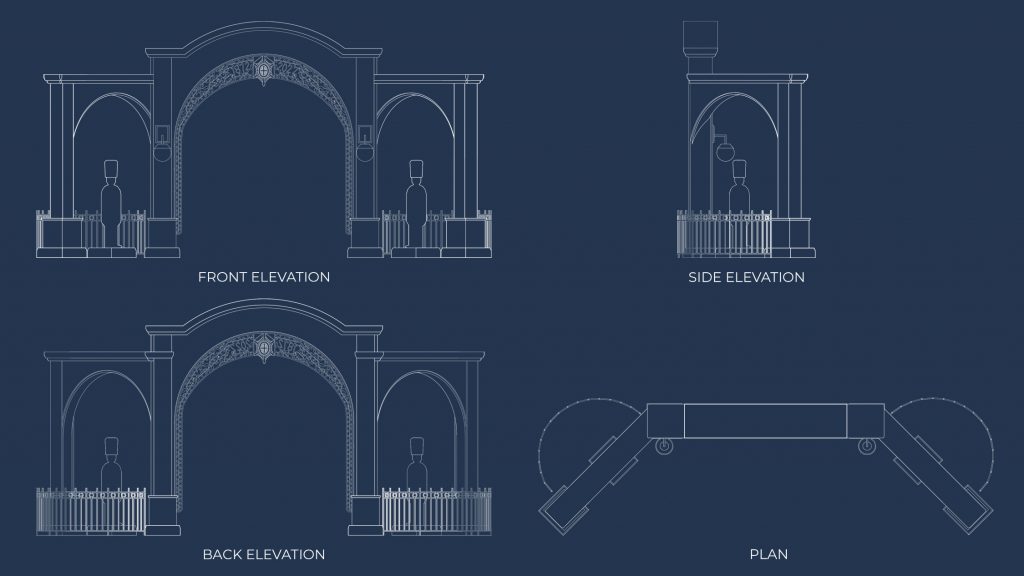
The proposed design unites the values of Confederation Park with the traditional sense of structure of the Governor General’s Foot Guards Regiment. The gateway alludes to the three arches found on the facade of Cartier Square Drill Hall. The three archways create a repetition of vertical elements in elevation, mimicking the symmetry of a line of guards. The use of iron plays an important role in our design as it provides a relief in the massing of the three arches. The idea behind the organic motif of the ironwork was to create an element that is representative of the natural features of Confederation Park, which in itself acts as a relief from its urban context of downtown Ottawa. This design pattern was created to provide an aspect of the park to meet you at the entrance. Placing the Guard’s Star, the emblem of the Governor General’s Foot Guards, at the centre of this ironwork was another major aspect of incorporating iron. The proposed gateway commemorates the 150 years of service of the Governor General’s Foot Guards in a monumental manner while understanding its purpose as a main entrance within its context of Confederation Park.
Here are the other seven proposals submitted to the GGFG.
Memory Lane
Finalist
Basil Currie, Wenjun Ma, Xinxin Wang
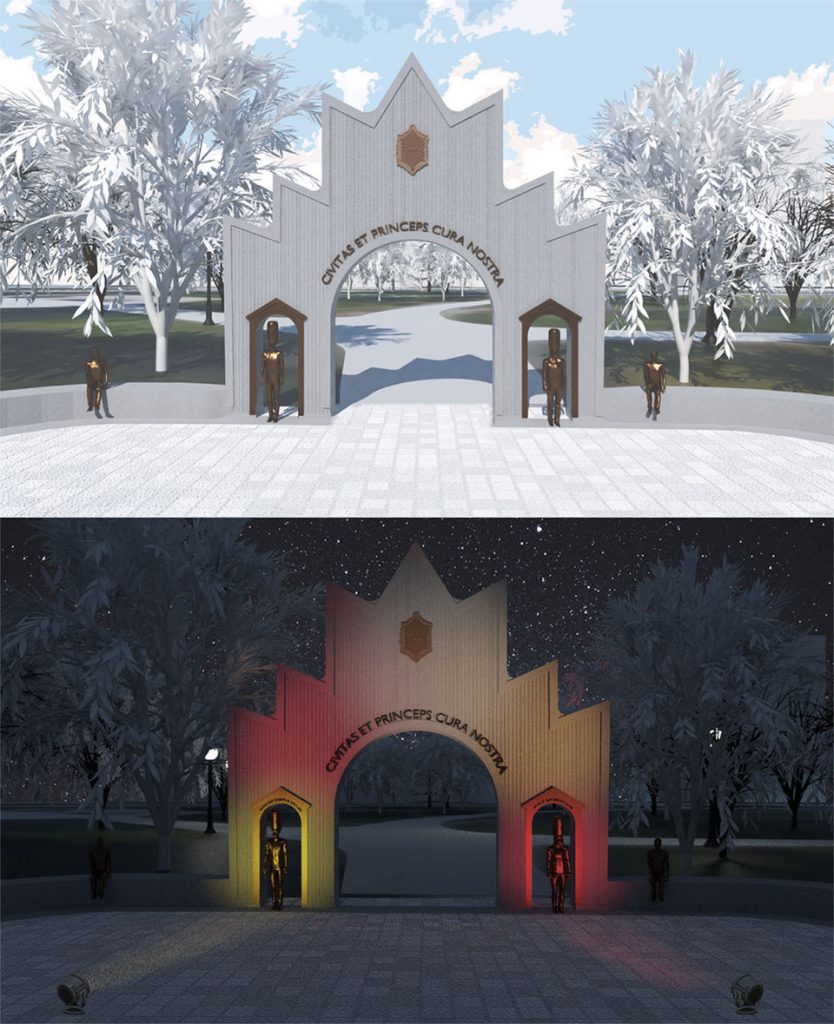
We’ve created a monument that commemorates all the significant figures and events in the history of the GGFG. The design of the entrance takes inspiration from the Canadian Maple Leaf and the buildings of Parliament Hill and the Drill Hall, both symbols of Canadian identity. Connecting the entrance to the pedestrian scale is a parapet that extends to the sidewalk in an embrace-like manner, defining the entrance and providing seating for the public. The parapet is to be engraved with the timeline and historical deeds of the Foot Guards and can be scaled up or down and even expanded as the history of the Foot Guards continues.
It was exciting to work alongside clients on a project with real-world implications. It made the course incredibly engaging. –Basil Currie
Radius Fidei/Ray of Loyalty
Finalist
Chrishan Mercurio, Nana Fukumoto, Maria Damaso
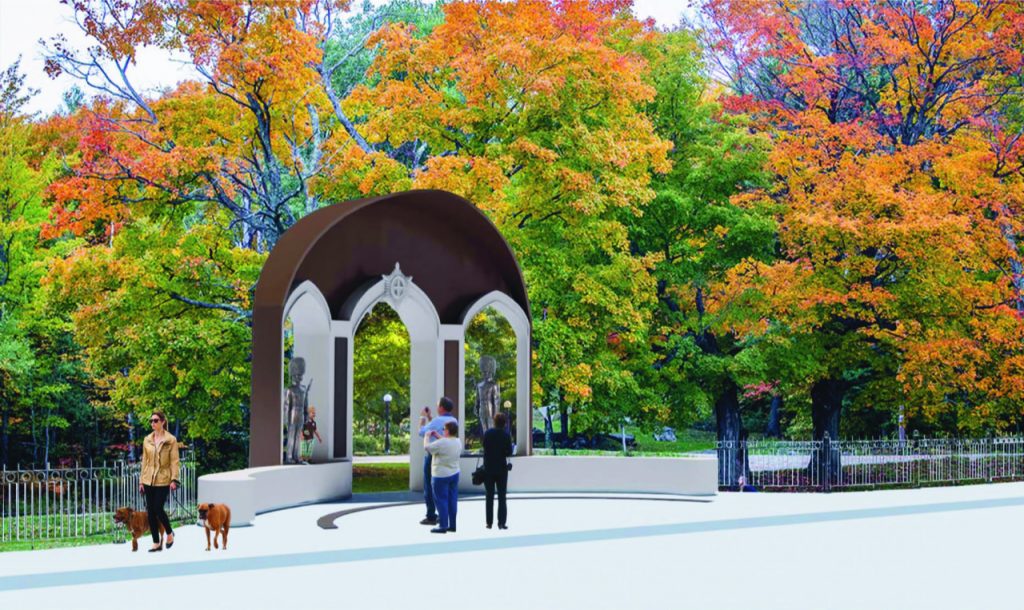
We aimed to create a structure that represents the tangible and intangible values of the site and the history behind the GGFG. Our project’s use of circles and curves is inspired by the GGFG’s symbology and the site context. These include the Cartier Square Drill Hall, the National War Monument, art made by the Anishinaabe Algonquin Nation, the GGFG emblem, and the picturesque landscape of the site. The main materials, bronze, granite, and sandstone, are inspired by the monuments and memorials surrounding Confederation Park. They are used in Radius Fidei to create a harmonious and cohesive composition alongside the existing monuments.
Throughout the project, we also received amazing feedback from our clients, the GGFG and the NCC, which helped us gain insight into the logistics of designing a public monument. – Maria Damaso
Gate of Stories
Finalist
Terissa Chalmers and Maya Thayalan
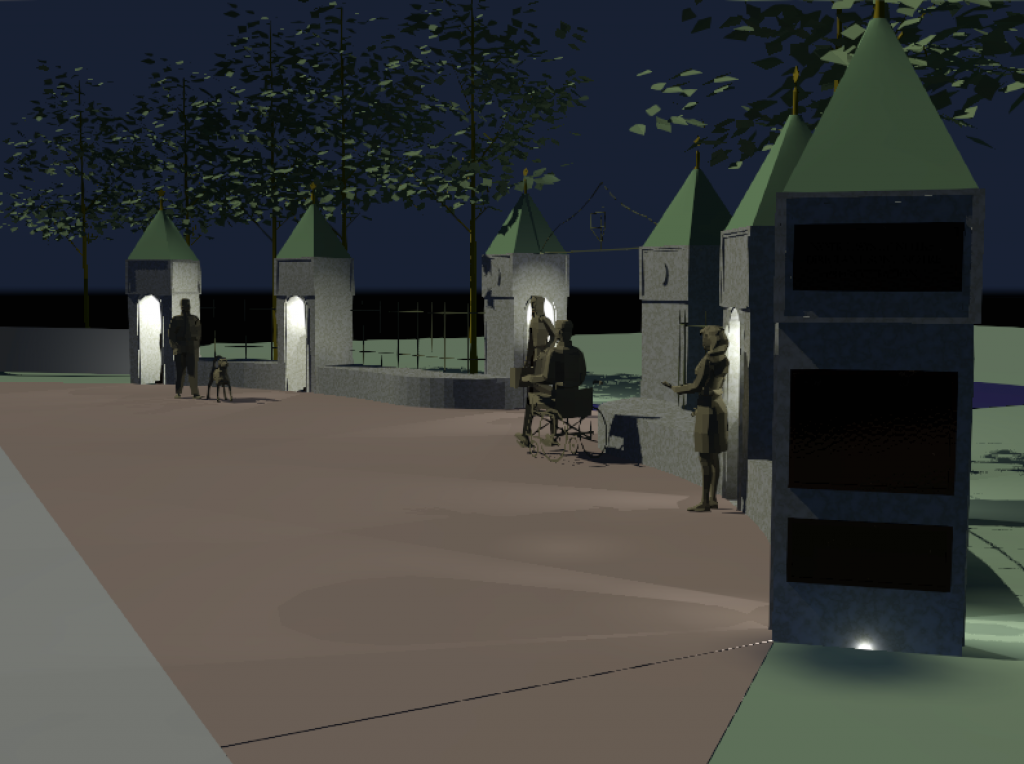
The goal is to give subtle nods to important aspects of Ottawa and the GGFG. The design features organic ironwork that represents the old Confederation Park trees and includes recognition of Indigenous representation. In addition, there is an ironwork header over the entrance of the gate, which features organic movement surrounding the coat of arms. There is also an option to include stained glass in this feature. The gate itself is made of reused stone, which sections and features bronze sentries. The stone on the parapet features a carved relief of the actions of the GGFG during their 150 years of service.
Working with a real client on something they want, with the ability to be creative, was an experience I will never forget. -Terissa Chalmers
A Key Stone for Canada
Cauri Ash and Dharshini Mahesh Babu
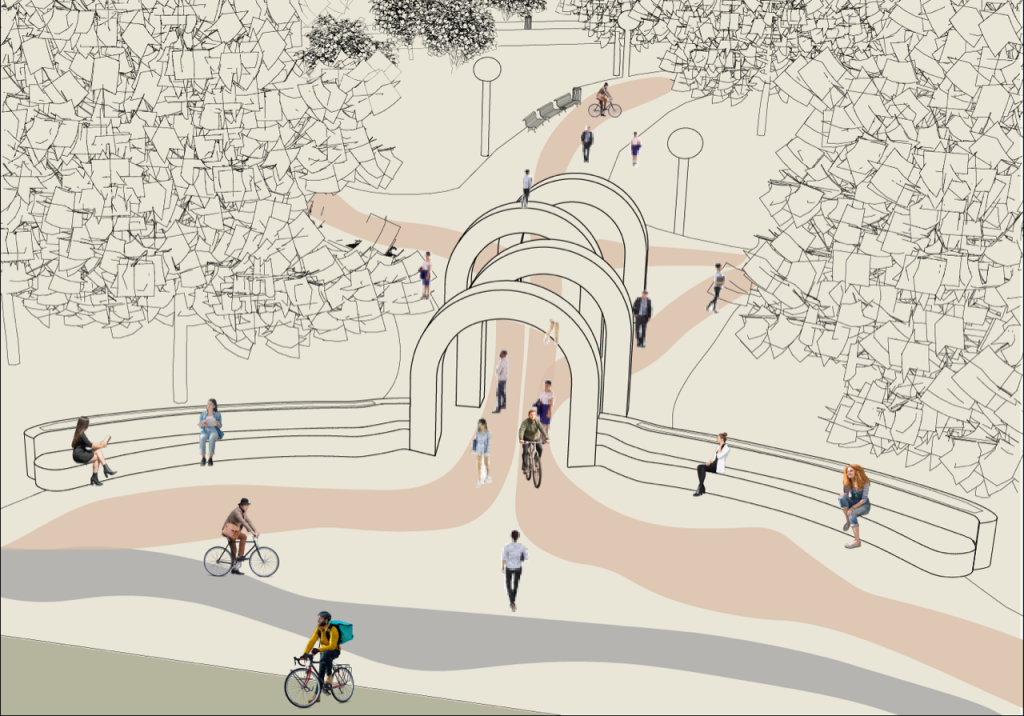
The materiality of the site is selected based on the context. The orientation of elements is chosen from the rhythmic movements of the GGFG. The landscaping connects to the surroundings. Sustainability is considered to honour Indigenous values. With the basic form of an arch, we express the strength of the regimen while making reference to the architecture of the Cartier Drill Hall. A series of arches in a weaving order symbolize the ongoing relationship between the regiment and Canadians. Overall, the entrance evokes a protective space through which the public can interact with the informational plaques and carefully curated symbols present within the entrance.
This project was challenging since, for many of us, it was our first experience working directly with a client. Being able to see the project unfold from start to finish with the possibility of seeing it in its tangible form within one of Ottawa’s most important parks was equally demanding and exciting. – Cauri Ash
The Vigilant Guards
Jaya Linfoot and Aram Payroveolia

The Vigilant Guards is a processional entryway into Confederation Park that emanates the longstanding military, humanitarian, and ceremonial presence of the Governor General’s Foot Guards. The gate uses principles of modularity, solid and void, as well as stoicism to create a grand homage to the regiment and other stakeholders while integrating respectfully into the existing setting, even improving circulation in the park. Visitors are drawn in by outstretched marble arms. Emblematic bronze arches signify the beginning of the journey through the procession. One side depicts scenes of humanitarian efforts via bronze reliefs in the stone pillars, while the other shows imagery of war efforts.
It was challenging balancing aesthetics with feasibility and the scale with the wishes of the client all while applying good conservation practices, but it was very rewarding.
– Jaya Linfoot
A Passage Through Time
Jillian Smigielski, Asiyah Ali
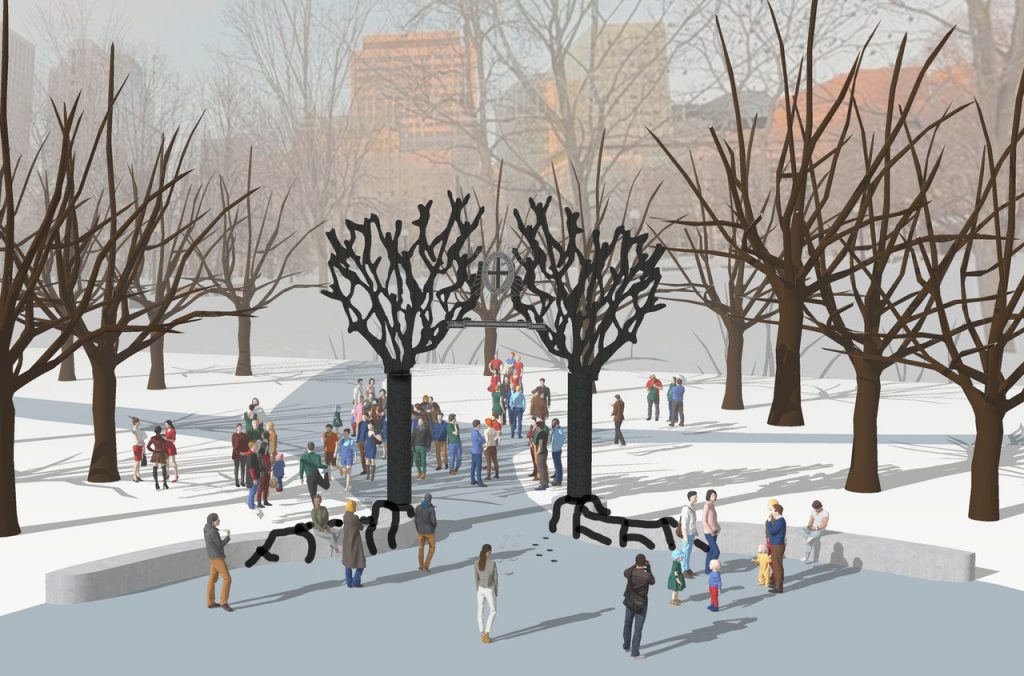
A Passage Through Time is a pair of trees that merge together in the form of an arch as an entrance to Confederation Park. The branches of the sculptural trees are people holding each other up to represent the citizens of Canada and the Governor General’s Foot Guards and how we have supported each other over the last 150 years. In the centre, where the trees meet, is the Cap Star, the emblem of the Governor General’s Foot Guards. The roots of the trees drape over the existing concrete parapets and represent the Indigenous peoples and how they are the roots of this land.
While working on this project we both learned a lot about the history of Confederation Park and the significant role of the Governor General’s Foot Guards. - Asiyah Ali
The March to Parliament
Madison Leonard and Dylan Jozkow
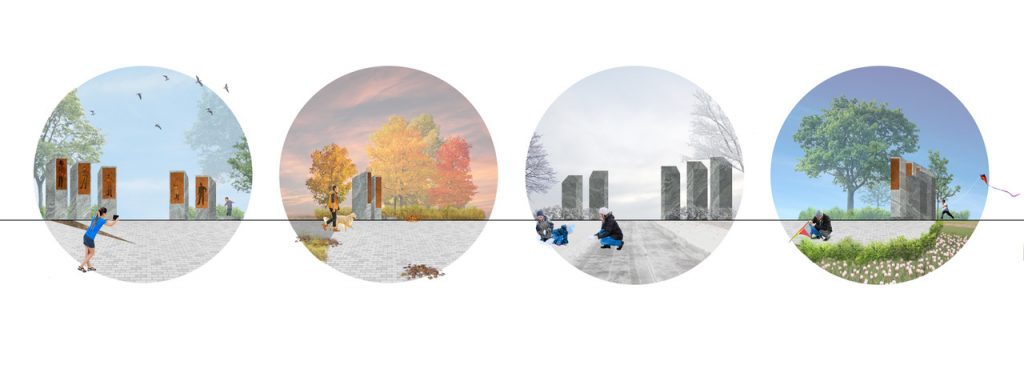
Our gate proposal was inspired by the processional marches carried out by the GGFG, which pass directly in front of the site. Our design features a progressively growing series of stone columns with mounted bronze relief statues of soldiers sporting different uniforms from the regiment’s 150 years of service. The final column was replaced with a short podium for pedestrians to pose upon, symbolically joining the GGFG’s lineage of honour and duty and making for a great photo! A stone marking in the ground points directly to parliament, not only orienting passersby but symbolizing the Guards continual dedication to the protection of Canada and its people.
The project was interesting in its challenge for us to interpret the mostly intangible heritage of the GGFF and create something tangible from it. The urban, public setting forced us to very carefully consider the circulation, lighting, and its multitude of uses throughout the seasons. -Dylan Jozkow